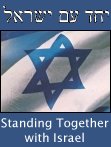These days, instead of making a pilgrimage to the Temple and offering a sacrifice, you read through the Haggadah, which is a reenactment text of the service, more or less. It is interesting though, that in comparison the liturgy on Yom Kippur, where the reenactment takes you into the Temple, to the service of the High Priest, as it describes, over and over, his service to God on Yom Kippur and the reaction of the assembly, in this case, the thing being reenacted is the rabbinic service of Passover. So what you are supposed to do, instead of a physical commandment drawn from the biblical text, is to spend the night discussing the meaning of the Exodus.
We were slaves to Pharaoh in Egypt; but God took us out from there, with a strong hand and an outstretched arm. And had the Holy One, blessed be He, not taken our ancestors out of Egypt--we, our children, and our children's children would still be enslaved to Pharaoh in Egypt. Therefore, even if we are all wise, all men of understanding, all well versed in the Torah--we would still be commanded to tell about the Exodus from Egypt; and whoever tells about it at length is worthy of praise.
The thing is, in it's current state at least, it is really a teaching text. You go through the Haggadah, and it takes you through the process of generating a midrash praising and extolling God based on parts of the text of the Exodus. And it teaches you to do that based on the paradigm of Rabbi Eliezer, Rabbi Yehoshua, Rabbi Elazar ben Azariah, Rabbi Akiva and Rabbi Tarfon telling the Pesach story over, all through the night, until it is time to read the morning Shema.
Once Rabbi Eliezer, Rabbi Yehoshua, Rabbi Elazar ben Azariah, Rabbi Akiva and Rabbi Tarfon were all celebrating the Seder in B'nai B'rak. And they told the story of the Exodus from Egypt the entire night, until their students came and told them, "our masters, the time has come for the morning recital of Shem
So first the Haggadah lays out a way to address the questions and attitudes of each of the four sons. More or less, it is setting the intellectual prototyes for how to engage people of varying mindset, from the most engaged to the least engaged.
But after that it goes into some detail itself generating a midrash about the number of miracles performed by God throughout the Exodus and the splitting of the Red Sea. The text is really playing a little game at that point, but the upshot, if you care to examine it, is that the text itself is providing an example of the generation of a midrash. It's revealing the midrashic process in the making.
IOW, you can read the text on two levels. The first, simple level allows you to fulfill the mitzvah of discussing the Exodus at the seder simply by reading through the Haggadah itself. But the second level of the text shows you how to be creative yourself, midrashically speaking. It provides a pattern for you to follow if you are so inclined, to take a verse and expand upon it by interpreting it through the aid of other verses. And it shows you the joy and the zest that this activity held for these particular men. And in that sense it becomes a teaching text, not just as the content it provides, but in terms of showing you how the technique itself and how it works.
In passing, it also provides a remarkable template of how the sages viewed Passover – a holiday celebrated in the elevating discourse that takes place in a group of friends, when one insight can spark others, leading to revelations about the abundance of God's intercession in human affairs. This interactive quality among friends and family, that is their notion of a Passover seder well done.







0 Comments:
Post a Comment
<< Home